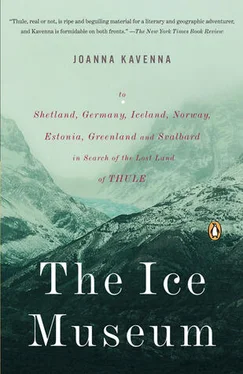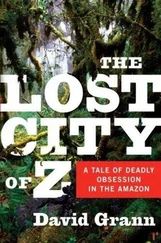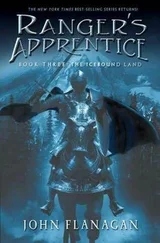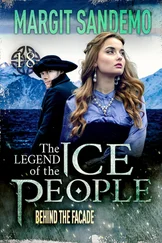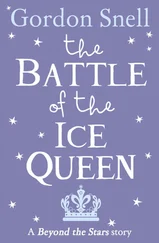After this I was given a handshake, told to take a pile of thermals and to be sure to write—and then I left.
Standing outside the tall house with its windows thick with dirt, I felt a strange sensation that Andrew had been laughing at me, laughing at everyone. It was odd that I—who had long been obsessed with the Arctic regions, and with this old tale of Thule—had a moment not really of hesitation but of startled pause. For a moment I felt that I wasn’t going to the most northerly island but that I was setting out for the centre of the earth.
The ship’s name was Aurora Borealis . If it kept afloat on the ice seas, it wasn’t thanks to the captain, who had crashed the ship two weeks earlier, holing the bow on a piece of shore. They had repaired the ship, but the captain feared the worst when he returned to the south. So he was in pre-emptive mourning for his job, though he tried to be cheerful during the voyage.
The ship was a smashed-up icebreaker. The passengers lolled in the saloon, smoking in the afternoons; they drank, they ate, they dozed, they read bumper books about Greenlandic wildlife. Total wilderness, everyone said all the time, it was a chant coming off the boat. It was like a moving convention, devoted to the worship of absolute vacancy. We were heading for Thule, the real-time Thule—the name shared between an Inuit village and a secret US Military base, hidden in the far north of the island. A dark comedy, this dual personality Thule.
The sea route to Thule passed along the western coast through multi-form bergs, cracked and twisted, rising to sharp points, drifting with the waves. Waves curdled around the base of the icebergs, coiling into the gaps in their surface. The haggard grey coasts were empty; the ship moved past black rocks, which looked like sloppy stacks of crumbling charcoal, spilling into the sea. At midnight, the spectral autumn version of the Northern Lights appeared, a sky full of swirling green and white forms, swelling from the horizon like fires. They pulsed at the corners of the sky, seeping slowly across the stars, ebbing to a silent rhythm. I stood on the deck, watching the patterns of the lights moving across the clouds.
There were orderly villages in the south, set up by the Danes. In Ilulissat, in the west, the houses were wooden, painted in bright colours. Four-wheel drives ploughed the dust from the streets and shops sold supplies. There were fields of sledge dogs, chained to rocks, and the edges of the town were a series of dirty wooden shacks, interspersed with rubbish dumps, piles of broken-down cars, engines from boats—junk-yard collections, stacked in people’s gardens. There was a Rasmussen museum in Ilulissat, celebrating the life of the Dane who brought the word Thule to this ice island. The museum was in the small house where Rasmussen’s family had lived for a while, with a view of bergs drifting on the fjord. Born in 1879, Rasmussen grew up speaking Danish and Greenlandic Inuit; his mother was of partly Inuit descent, and his father was a Danish missionary. Finishing school in Denmark, Rasmussen tried out opera singing and acting, with scant success. He turned to writing, trying out journalism, and was sent on trips to the north, to Sweden, to Iceland. He met another ambitious Dane, Mylius Eriksen, and they decided to follow the Viking tradition, the Viking sailor Erik the Red, and sail to Greenland. It was a conscious imitation of their historical forebears, forebears known only through mythologized accounts: The Saga of Erik the Red, The Saga of the Greenlanders . It turned out badly for Mylius Eriksen, who later suffered a frozen death in eastern Greenland. His body was lost for decades, the details of his death known only because another member of the expedition left a note on the ice explaining what had happened. Rasmussen became a writer, sending back reports from northern Greenland, naming the Inuit settlers he found ‘the Thule Culture,’ and making Thule expeditions across Greenland and into Alaska.
When Rasmussen set up camp at Thule in 1910, the country was still unknown in many places, its frozen coast attracting polar explorers looking for a last camp before they set out further north. Peary had based himself up in the north-west of Greenland, in the area around Thule. He sold the Inuit guns, and left his descendants in the villages of the far north. In 1910, Greenland was inhabited, but its inhabitants were subdued by the enormity of the rocks, the storms raging across the cliffs, the darkness of the winters. For centuries, they lived in turf huts, indistinguishable from the moss rocks. Rasmussen suggested that the remote place he named was an ‘Ultima Thule’ in the superlative sense, an Ultima Thule of blasted cliffs, an Ultima Thule of ice islands. He had found the Ultima Thule of northerly places, the most extreme and bleak and compelling. His naming had nothing to do with Pytheas, he hardly referred to the musings of Strabo and Pliny and Pomponius Mela. Rasmussen used Thule as it had come to be understood, as a literary term, a piece of scene-setting myth.
It drew together the beauty and terror of an immense ice-plain, it seemed to fit with the strange clash of disconsolation and euphoria I felt in Greenland. Greenland was a beautiful series of cliffs, and then it was a vast uninhabitable ice-plain, the ice crushing 90 per cent of the land. An ancient land, its rocks ravaged by ice, in places nearly four billion years old.
It offered an absolute and unyielding sort of silence. Its physical vastness was matched by its antiquity. Greenland was an enormous plain of ice, the largest island, the most ancient rock in the world. In none of the other places I had been had the concerns of the human world seemed so small. Others had understood this feeling; Herman Melville had encapsulated the strange presence of the empty ice: ‘And as for solitariness, the great forests of the north, the expanses of unnavigated waters, the Greenland ice-fields, are the pro-foundest of solitudes to a human observer.’ The solitude of the ice, the solitude even of the deck, the vast rolling ocean, the ship heeling like a drunk, the blank sides of the mountains, the ice cap glinting above.
In Ilulissat there were glacier tours, lines of boats circling the ice-towers in the fjord. There were queues of tourists watching the sea forming into smashed sludge, admiring the pieces of pancake-ice colliding and splitting. There were scattered rags of ice lying on the water, pushed by the wind. There were masses of ice rising out of the sea, stern and solitary, the waves swirling around their bases. The mountains stretched behind the ice, pale in the sun, with contours like muscles along their sides, coloured red with moss. The ice-fjord was mesmerizing: so much ice, and it was only the tattered overspill of an immense glacier, and the immense glacier only a small fragment of the ice cap. It looked idyllic as the boat moved out of Ilulissat. The ice castles were blue and white, the sunset added a rich bloodied shade to the piles of drifting ice, and the bergs made a fine slapping sound as they bounced on the sea. The lights of the small town shimmered on the hills; the inland ice stretched beyond, a white snowfield, glowing red under the sky. The boat moved slowly through the congealed sea. The ice lay in the water; the clear sea showed the submerged forms of the bergs; the blue ice sparkled beneath the surface. At night everything was still, the wind dropped, and the moon rose, large and round. In the north there was still a narrow strip of evening light. To the east, the mountains lay stacked up along the coast, dark against the dusk sky. The bergs floated alongside the ship, forced by the pressure of the waves into fabulous shapes. There was one with stalactites and stalagmites around a great hole, like the mouth of a semi-submerged sea monster, roaring as the sea poured through the gaps between its teeth. Another was like an ice sculpture of a pyramid, its sides smooth and perfectly planed. They were infinitely diverse, thousands of chunks from the ice cap, the oldest bergs a deep blue, their colours reflecting onto the sea.
Читать дальше
